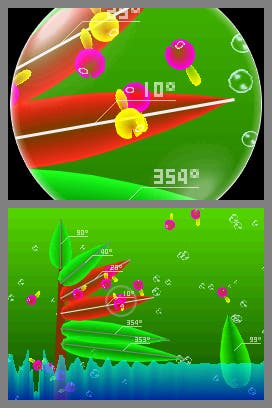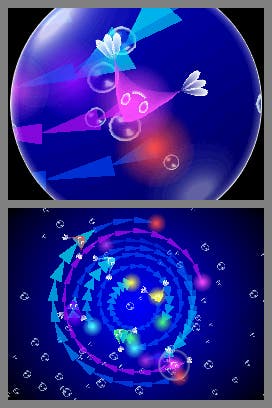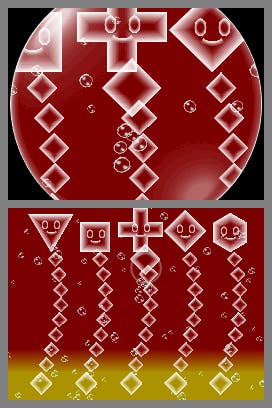Electroplankton
Long player.
Nintendo really is turning into the Willy Wonka of games companies. While others continually churn out perfectly exciting gaming confectionary (the equivalents of Yorkies, Mars Bars, Milk Buttons and so on, with the occasional Chomp or Curly-Wurly thrown in to confuse the taste buds), Nintendo seems to spend most of its time working on the kind of gastronomic peculiarities that make you convulse pleasantly, or chocolate biscuits that you have to coax out of the packet by cooing gently.
Electroplankton, were it a sweet, would certainly belong in the second category. Though it calls the DS home, it's not even a game; instead it's a kind of music mixer that allows you to build up simple plinky-plonky tunes by manipulating disco-dabbling sea creatures with your stylus, and occasionally blathering into the microphone. Whether you enjoy it or not is mostly a question of how much time you're prepared to put into it. Some would say "entirely" rather than "mostly", but we've got a few reservations in that respect, which we'll get onto a bit later.
First things first: a bit more explanation. Electroplankton is the brainchild of Toshio Iwai, a composer you've probably never heard of, and consists of ten different ways to make music. The best way to explain it is to go through them one by one.
Number one, Tracy, gives you control of six jolly little plankton types. By putting your stylus point on one and dragging it across the screen in a straight line, you prompt him to follow that path at a pace similar to your stylus stroke - little patters of music bubbling forth from the speakers or bundled headphones as he goes. Each of your merry little urchins makes a different kind of sound, and you can vary the composition by drawing different patterns for them to follow and by varying your stroke speed. With the littluns each caught on loop (tapping them again brings them to a halt), you can build up a tune layer by layer.

Number two, Hanenbow, is what you might call the office favourite. The primary focus is a little tree sticking out of the water with six leaves. A seventh sits on the left of the screen. At intervals, little sea creatures are propelled from the seventh toward the other six. When one of them hits a leaf, it makes a pleasant noise, and by using your stylus to change the angles of the leaves you can get them all to bounce around the plant and create soothing little melodies - each creature's contribution concluding with a dainty "plop" as it lands back in the water below.
Number three, Luminaria, might be responsible for the quickest results. Four star-shaped creatures occupy the corners of the touch-screen, and dotted around are various arrows. Tapping an arrow allows you to rotate it round to one of eight positions. Tapping one of the creatures sets it off, and it follows the course of the arrows, with each creature moving at a different speed and making different noises, and each arrow varying that sound.
Number four, Sun-Animalcule, involves dotting the screen with tiny blobs, which emit sound when they're struck by bubbles rising up the screen - making different noises depending on their position and growing in size and starting to smile as they do so, before eventually popping.
Number five, Rec-Rec, has been responsible for the most sordid misuse of the DS since we started using PictoChat to send each other rude messages and scribblings. There are four fish moving along the screen bar by bar, and each time one comes around you can tell it to record your voice - or anything else you might happen to expose the microphone to - and then hear it played back. Each fish does different things with the noise, and with a solid drumbeat behind them you're left to explore the possibilities. Our best creation, known as "Monkey See Monkey Do", involves short high-pitched use of the word "monkey" on loop, punctuated with "see" and "do" and layered on top of a baseline consisting of an elongated utterance of the word "balls". What's particularly worrying is that certain of us can't get it out of our heads.

Number six, Nanocarp, has yet to really capture our interest. The idea appears to be stirring the water around some confused little creatures so that they react musically to each wave flowing away from your stylus tip.
Number seven, Lumiloop, proved more popular after a little while. Five circular types need spinning with your stylus like plates, gradually filling your ears with pleasant ambient noise. Were it not for their rising and falling we might let them quietly guide us through writing this piece.
Number eight, Marine-Snow, sees you tapping little underwater snowflake-style creatures one by one. They emit a sound and then swap places with the next flake, and before too long you're at a loss for which makes which sound, but the results are sometimes randomly absorbing.
Number nine, Beatnes, vies with Hanenbow and Rec-Rec for 'favourite' status. With a classic Nintendo tune (like the Super Mario. Bros invincibility jingle) buzzing along on loop, you tap one of five icons along the top, each representing a classic NES game noise, and then tap the little diamond-shaped icons wiggling beneath them to build up a tune. Each repeats itself at a logical interval for a little while and then stops, but the results are quite enjoyable right from the moment you start peppering the screen with stylus pokes.
Finally, number ten, Volvoice, is another microphone-based idea. Quite simply, you record a sound or a phrase and then hit various icons to hear it played back in distorted manner. The results are novel if nothing else.

By this stage, you've every right to be a little confused. Electroplankton's peculiar little array of "sound tests" probably aren't what you anticipated - even if you had a rough idea of what to expect. And although given enough practice they do yield absorbing, exotic, melodic and even exciting results, surely something this obviously chaotic can't be the exciting new "instrument" Nintendo tried to position it as during one of the quirkier moments of its tubthumping E3 press conference this May?
Or can they? As we've been writing this, our latest Hanenbow creation - a combination of leaves angled in a way completely unique to the whim of our shaky stylus hand - has been quietly chirping away soothingly in the background. Earlier we found ourselves so excited by our ditty little Monkey tune that we recorded it and sent it to our friends. Then we spent close to half an hour simply "playing" Beatnes to ourselves.
What's more, each of the ten has a few little subtleties to uncover. Hanenbow features several plant shapes (one with the leaves all on one side rather than cupped upward like flower petals, for example) and the leaves turn to brown and can even blossom depending on what you do with them. Beatnes features various sound schemes, and it's possible to use the d-pad to change tempo. We've not even mentioned the top-screen either, which zooms in and out of certain areas at your command, acting like the sort of "visualisation" familiar to users of PC music playback applications like Winamp and iTunes. Nor have we mentioned the game's "Audience mode".
It's easy to be dismissive of Electroplankton, but given a proper chance it exposes itself as more than a novelty - and your enthusiasm for it will owe a lot to your enthusiasm for creativity in general. If you're the sort of person who plays games or listens to CDs but never dreams of making them, this probably isn't for you.
Frustratingly, those of us who do take to it may find it lets itself down with a few technical oversights, the biggest of which is that there's no facility to save any of your compositions unless you take your own steps (hooking up the headphone output to a stereo line-in, for example). Some might argue that you wouldn't expect a flute or a cello to record whatever came out of it, but then neither of those has a Flash-based memory solution built in, right? Likewise it's a little frustrating that some sections, particularly Beatnes, let your music vanish after a set amount of time - often far too soon for you to show off to whoever's there with you, which is what you'll feel like doing when something comes together nicely.
In spite of these flaws, however, Electroplankton is undoubtedly an arresting piece of software. One would hope that its arrival in the West (trumpeted, or perhaps more accurately "Tracy-ed", at this year's E3) earns it a great deal of attention. There have been times when we'd far rather bite down on a nice Yorkie or even a bit of virtual Toblerone during our time with it, but as we reluctantly prepare to call an end to our latest Hanenbow, it's worth reflecting that Nintendo's managed to deliver a Golden Ticket to whoever wants one.
Electroplankton is due out in the West sometime in the future, final release date TBC. It's perfectly usable in Japanese however, and comes with a pair of bundled blue headphones.


.png?width=291&height=164&fit=crop&quality=80&format=jpg&auto=webp)




.jpg?width=291&height=164&fit=crop&quality=80&format=jpg&auto=webp)
